Artificial plants for aquarium: uses, pros and cons
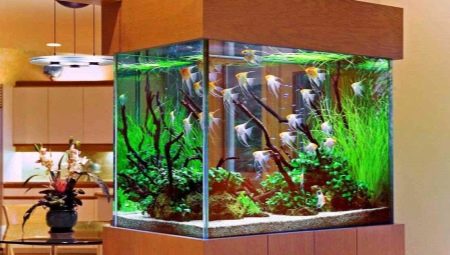
Living plants in an aquarium perform a number of important functions - they help maintain optimal microflora in an artificial reservoir and saturate the water with oxygen. To prevent living plantations from getting sick and growing randomly, they need to be properly looked after, and this will require a lot of time and certain knowledge. If the owner of the aquarium with fish does not have such, he can choose artificial plants.... Consider their pros and cons, as well as give advice on choosing and proper care.
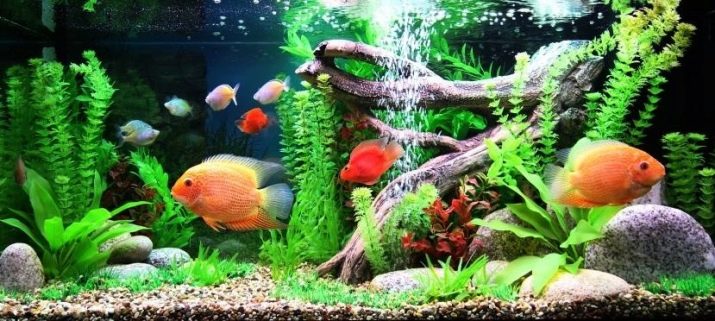
Advantages and disadvantages
Aquarium artificial algae can be an alternative to living grass. Of course, they will not be able to release oxygen to support the life of fish and numerous microorganisms that inhabit the artificial reservoir. However, modern air aerators are able to solve this issue as well. If you compare natural aquarium plantings and artificial ones, you can see the many advantages of the latter.
- Unpretentiousness... Inanimate algae do not care about the state of the microflora in the aquarium, they do not require specialized care (proper lighting, the introduction of nutrient substrates). To maintain aesthetics, you just need to systematically rinse the plants under water - such manipulations will not require much effort and time from the aquarist.
- Long service life... Well-executed plantings are capable of not changing their appearance for 5-7 years. They do not rot or be eaten by fish.
- Financial affordability. Artificial grass is almost always cheaper than real grass.
- Huge selection... Thanks to the rich assortment of inanimate flora, everyone will be able to purchase artificial analogs of the rarest exotic plants, which will be visually difficult to distinguish from living ones. A large selection allows you to make any fantasy come true and create an original and unique design of an artificial reservoir.
- Ease of use. Plantings can be transplanted, changed compositions - and all this without prejudice to their appearance.
- Harmless to the inhabitants of the aquarium. Quality artificial plantations are made from environmentally friendly and safe materials.
- Artificial grass is "not afraid" of burrowing aquarium inhabitants, since it does not have a root system.
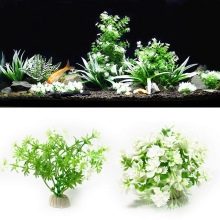
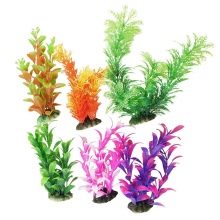
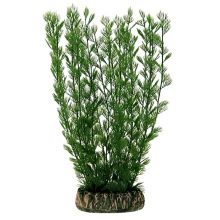
Despite the above advantages, some aquarists still prefer natural algae. People argue their choice by the presence of significant drawbacks that non-living vegetation has. Let's consider the main ones:
- the inability to purify water from nitrates and other compounds harmful to the health of fish;
- the emergence of stagnant zones due to the lack of a developed root system;
- the risks of wounds in fish when they come into contact with the sharp edges of products (this applies to cheap low-quality grass);
- loss of paint during long-term use (products of poor quality are most susceptible to fading).
To partially neutralize these disadvantages, it is recommended to use live flora together with artificial (in approximately the same proportions). Thus, you can create comfortable conditions for keeping fish and at the same time not burden yourself too much with caring for real algae.
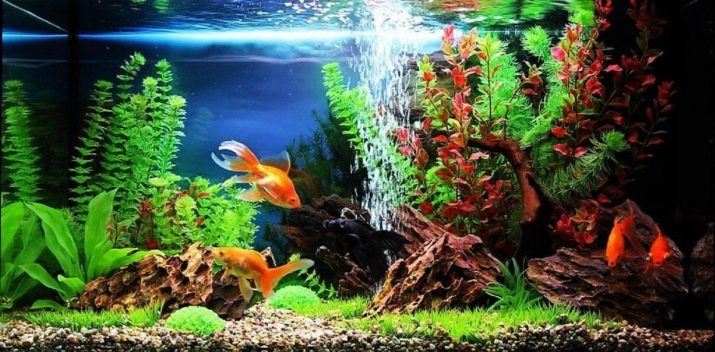
Selection recommendations
Pet shops offer a wide variety of artificial vegetation for aquariums. Among the goods dazzling on the shelves, there are often substandard products. To select plantations that are safe for fish health, it is important to follow a number of rules when buying.
- Poor quality artificial vegetation with prolonged use begins to disintegrate, endowing water with toxic substances. To prevent this from happening, you should make sure that there is no unpleasant smell from the plastic. It is worth giving preference to hard types of rubber, rather than soft.
- You should not buy algae, having an unnatural bright color. Most likely, aggressive coloring compositions were used in their manufacture.
- Carefully inspect the product - it should be evenly painted over, and the paint layer adhere well to the base. In case of pigment delamination, it is best to refuse to purchase the product.
- Experienced aquarists advise choosing vegetation with massive, smooth leaves. - washing them is much faster and easier than decor with carved small leaves.

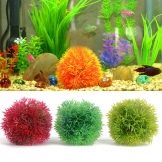
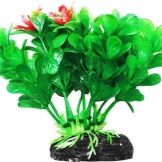

If possible, it is better to buy artificial grass for the aquarium, made of polyamide or silk. These two materials are absolutely safe for the health of fish, and the vegetation from them looks more natural.
Their only drawback, compared to plastic and rubber decor, is their fragility. After a year of operation, the plants begin to rapidly lose their aesthetics and will soon require replacement.
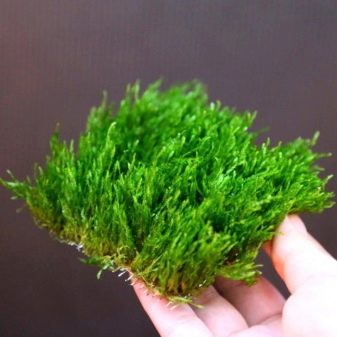
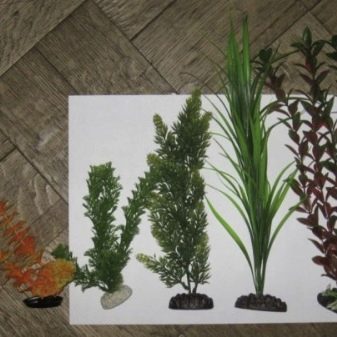
How to arrange an aquarium?
Decorating an aquarium takes a lot of creativity. Having shown imagination, you can create a luxurious and elegant home for fish from an unremarkable aquarium. Containers are made out in various ways - here everything will depend on the personal preferences of the fish breeder. It is up to him to decide what kind of decor and in what quantity is needed. However, there are some good tips to consider:
- if plantings of flashy, bright colors are chosen, you need to pick up the soil in calmer colors (for these purposes, you can also take shells);
- first of all, you need to hide equipment (for example, a filter or compressor) behind the vegetation;
- the farthest part of the aquarium (back wall) is formed by long algae, however, their length should not exceed the height of the aquarium itself;
- in the center, you can place plants, the length of which will be approximately 1/3 of the height of the aquarium;
- to decorate the space near the front wall, you need to use small decor of various sizes, otherwise the composition located at the back will not be visible;
- to draw attention to the center of the aquarium, you can place a snag, beautiful large stones or other decor in this area.

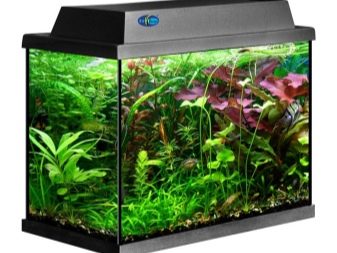
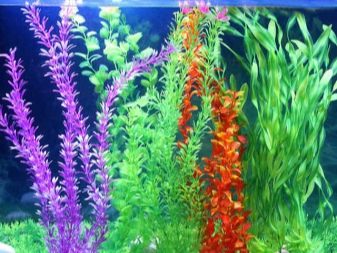
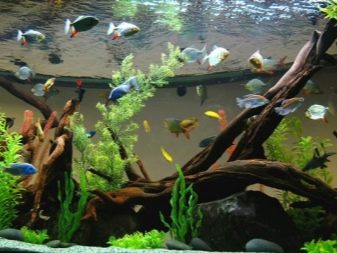
When decorating an aquarium, you should not arrange the plants in one row - you need to randomly "plant" them around the perimeter of the entire container.
In order not to overdo it with an abundance of vegetation, you should not buy a lot of different decor. - 2-3 types of grass will be enough for medium-sized aquariums. It is best to choose algae of various shades and sizes that mimic natural flora as much as possible.

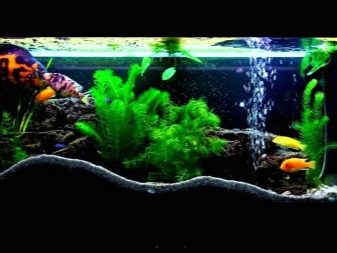
Correct care
Artificial aquarium plants, like living ones, need some care. The fact is that the reservoir has its own microflora - useful and harmful microorganisms live there. Due to these inhabitants, plaque forms over time on the walls of the container, decor items, on the surface of natural or artificial grass. The situation will be aggravated if harmful algae (such as black beard) are introduced into the aquarium. In this case, the decor is capable of being covered with a layer of various microorganisms.
As the plantings become dirty, they must be thoroughly washed. Plants can be treated in several effective ways.
- With boiling water. To do this, you need to place the decor in a container of boiling water for 15 minutes. After this time, the plants are removed, the plaque from their surface is cleaned with a hard sponge or scraper.
- Whitening agents. For cleaning, you need to prepare a special solution. For this, whiteness is mixed with water in a ratio of 1/9. Decorations must be placed in the resulting solution and wait 15-20 minutes. After that, artificial plantations should be thoroughly rinsed under the pressure of running water.

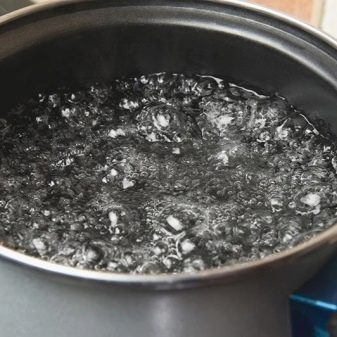
For a deeper bleach removal, you can use products with a chlorine-neutralizing effect.
The above methods are ideal for cleaning plastic and rubber aquarium decorations. But they are not suitable for removing dirt from silk products. For cleaning silk decor, it is recommended to use a product made from salt and lemon juice. The resulting mixture is applied in a thin layer to the surface of the plantings and spread with a toothbrush. After removing the plaque, the products are thoroughly washed under warm running water.
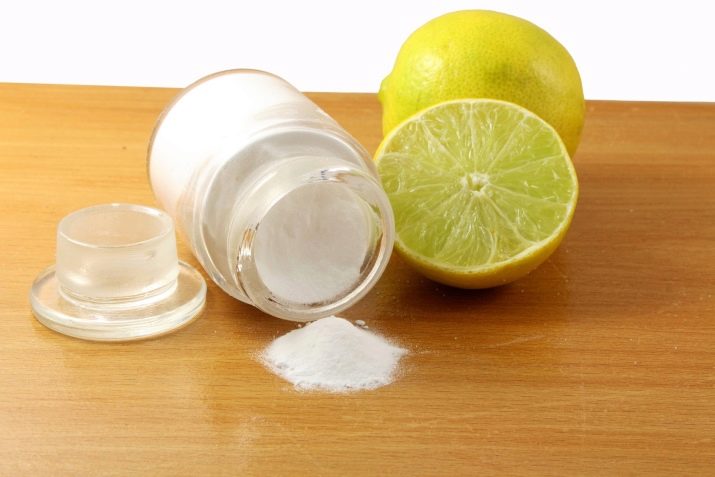
Experienced aquarists are advised to have special snails in the pond so that the plants do not need frequent care. They feed on algae, preventing intense plaque build-up on the surface of the decor and on the walls of the vessel. With them, you can clean the aquarium much less often.
For information on how to attach artificial plants for an aquarium, see the next video.








